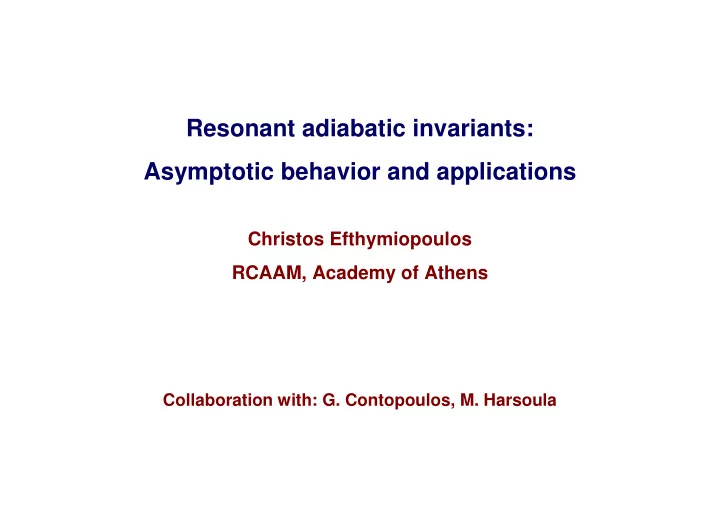

Resonant adiabatic invariants: Asymptotic behavior and applications Christos Efthymiopoulos RCAAM, Academy of Athens Collaboration with: G. Contopoulos, M. Harsoula
"Adiabatic" condition: one frequency is small Celestial Mechanics: Secular frequencies (of order µ ) compared to mean motion frequencies (of order unity) Astrodynamics: precession versus orbital frequencies Magnetospheres of stars and planets: "mirror" versus gyration frequencies (e.g. motion of charged particles in the Earth's van Allen zones, or in the current sheet formed in the Earth's magnetotail) "In the inner belt, particles are trapped in the Earth's nonlinear magnetic field. Particles gyrate and move along field lines. As particles encounter regions of larger density of magnetic field lines, their "longitudinal" velocity is slowed and can be reversed, reflecting the particle. This causes the particles to bounce back and forth between the Earth's poles.[29] Globally, the motion of these trapped particles is chaotic. [30]"
The magnetic bottle paradigm ρ B z B ρ z non-equatorial orbits: net "spring" force ∆ F z Equatorial orbits: gyrations F z v g B z B ρ 1 / 2 ω c =B z q/m ∂ v B 2 2 g ρ ω = R c =mv g /(B z q) ∂ ρ ∂ 2 B z 2 z B ρ ' F z '
A simple example B z =B 0 + Β 2 (z 2 - ρ 2 /2) Β ρ =- Β 2 ρ z r r = ∇ × B A Α z =A ρ =0 vector potential Section: ρ =0, p ρ >0 Orbits: Non-resonant Resonant chaotic Approximate integral v 2 g µ = ω 2 c
Hamiltonian formulation r r + p q A 2 ( ) = H (velocity modulus preserved) m 2 For p φ =0 Basic form
Non-resonant adiabatic invariants Canonical formalism - Method of Dragt and Finn (1976) Action - angle canonical pair for the gyration Series of near-identity canonical transformations Hamiltonian in the new variables has the normalized form Normal form structure
Formal process in polynomial variables
iv) Normalization algorithm with composition of Lie series Homological equation Main issue: the operator D ω is not diagonal
Solution: solve the homological equation together for terms in groups
Example Back-transform I 1 to the original canonical variables Compute level curves of I 1 on the surface of section
How to deal with resonances? Bifurcation of resonances at z=P z =0 For given value of the energy, one has: 2 in Z. where coef(I 1 ) is the coefficient in front of q 2 Compute the value of I 1 where a resonance bifurcates by solving m 1 ω 1 ( Ι 1 )+ m 2 ω 2 ( Ι 1 )=0 = 0
Combine "book-keeping" with "detuning" (Pucacco & collaborators) The "kernel" term of the normalization scheme acquires the usual form Introduce a second pair of complex canonical variables
Choice of resonant module : for monomials of the form Resonant integral: Back transform to the original variables
Asymptotic behavior The formal adiabatic invariant series exhibit an asymptotic behavior Claims of "convergence" (Engel et al. 1995) Remainder size at different are just an artifact of not reaching sufficiently "distances" ρ from the origin high normalization order ρ =0.2 ρ =0.1 ρ =0.05 ρ =0.01
"Escape" chaotic dynamics and invariant manifolds Infinitely many transitions of the central Equipotential lines at the orbit from stability to instability and vice versa critical energy
Conclusions: 1. Computation of non-resonant adiabatic invariants to a high normalization order : Gives quite precise adiabatic invariants Computation of the mirror frequency ω 2 , as well as of high-order corrections to the gyro-frequency. Computation of the bifurcation energies for resonances Reveals the asymptotic character of the formal series 2. Resonant adiabatic invariants Compute first the non-resonant series "Restructure" the Hamiltonian by a combination of "book-keeping" with "detuning" Usual procedure allows to obtain the phase portraits in the neighborhood of resonances Prediction of the critical energy for the global onset of chaos 3. Dynamics of escapes: correlation with manifold dynamics
Recommend
More recommend